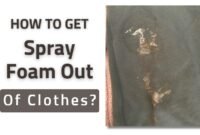Do you need soundproofing spray foam for existing walls, such as interior walls? If so, it’s important to gather information before proceeding. Understanding the type of insulation, including spray foam insulation good for soundproofing, is crucial in making informed decisions.
This knowledge will help you choose the right foam insulation for soundproofing, ensuring effective noise reduction and enhanced indoor air quality. So, to put your mind at ease, please see the briefs below.
Does Spray Foam Insulation Reduce Noise?
Before deciding on soundproofing existing walls, it’s essential to examine the composition and density of the substance you intend to use. The type of insulation, such as high expansion spray foam, plays a significant role in its effectiveness for soundproofing.
Understanding these factors can help you determine if the insulation is good for soundproofing your specific space.
To inhibit sound transmission through the wall, you surely need a substance that can absorb, deflect, and dampen the sound as well as disconnect the layers. Several substances have NRC and STC values that are useful regarding soundproofing insulation alternatives.
You will realize why open-plus-closed-cell polyurethane may not be the ideal choice for soundproofing. While it has high thermal qualities, it lacks the bulk necessary to absorb sound waves effectively.
When considering spray foam insulation for soundproofing, it’s important to weigh its thermal insulation properties against its ability to reduce noise transmission through walls.

The solidified foam produces a stiff substance that also obstructs absorption. Combining a tougher material alongside closed or open cells gives you enhanced resonance, while a softer, extra-airy substance dampens it.
Read also: Should You Insulate Basement Ceiling?
The same feature that makes spray foam suitable for storm and earthquake regions also makes it less suitable for soundproofing. Its ability to hold wall materials together, including the crawl space ceiling and crawl space walls, allows sound waves to pass through more readily.
This aspect should be considered when evaluating spray foam insulation that is good for soundproofing in areas prone to air leakage.—the wall structure, foam density, and wall coating all impact performance.
To put your mind at ease about soundproofing spray foam for existing walls, consider how insulation affects the STC score of a 2″x4″ dividing wall with 1/2″ drywall along both surfaces and a starting STC of between 33 and 35.
| Insulation | Thickness | NRC | STC |
| Open Cell Polyurethane | 3” | 0.70 | 37-39 |
| Closed Cell Polyurethane | 2.75” | 0.70 | 36 |
| Rockwool Safe’n’Sound Batten | 3” | 01.05 | 45 |
| Rockboard 60 | 3” | 1.10 | 52 |
| Owen-Corning R-11 Batten | 3.5” | 0.95 | 39 |
| Owen-Corning Fiberglass 703 | 3” | 1.10 | 52 |
As evidenced by the comparative table, spray foam may not be the greatest option for soundproofing. The noise muffling values of closed-cell spray foam insulation are the lowest.
Open-cell polyurethane spray foam appears to be better than fiberglass batten insulation in noise suppression. When contrasted with rock wool and fiberglass rigid insulation, these foam forms perform much worse.
Although the numbers should suggest an enhancement in the sound suppression of a normal 24-dividing wall, the foam’s adherence to the components allows audio vibrations to flow through readily.
Furthermore, the hardened foam’s open or closed cells boost semi-frequency resonance, altering the audio experience. It has great thermal capacity but is a poor soundproofing substance.
Best Spray Foam For Soundproofing
Discussing soundproofing for existing walls, open-cell spray foam is commonly used due to its cost-effectiveness and numerous air pockets that effectively absorb sound. While it may not provide the same level of water resistance as closed-cell foam, its insulating properties make it a viable option for reducing noise in interior spaces.
While closed-cell foam is denser and even includes an air seal, open-cell foam remains effective at absorbing audio and providing sound insulation.
This is due to soundproofing injection foam’s ability not to transfer vibrations, such as closed-cell foam. Then, since it broadens much more than closed-cell foam, it even ends up wrapping a wider base, and the bulkier the substance, the more audio it can absorb.
Spray foam is beneficial for soundproofing not only because of its acoustic properties but also due to its ability to expand and cover the entire outer layer with ease, acting as a thermal insulator and sound-deadening material.
Installing insulation in oddly shaped areas like walls and ceilings or exterior walls with materials like rock wool and fiberglass can be challenging, as it requires precise cutting to fit.
Furthermore, rockwool and fiberglass settle with time and leave a little open area on the top or even on the sides. Then, as you all know, insulation for both audio and heat necessitates that every space be entirely sealed, no matter how tiny.
As a result, spray foam is far more adaptable and simple to use compared to other conventional insulators since it can easily expand and fill every available hole.
Moreover, the types of soundproofing spray foam, like open-cell and closed-cell varieties, contain fire retardants and methylene diphenyl diisocyanate, enhancing their safety profile. The construction material of the walls also influences the effectiveness of spray foam work in soundproofing.
Read also: Is Spray Foam Insulation Waterproof?
Acoustic spray foam and cell foam insulation are specifically designed to reduce noise transmission, making them ideal for residential and commercial applications.
So, that’s the information about soundproofing spray foam for existing walls. You can look up more information about it or learn more about spray foam from professionals knowledgeable about the subject.


